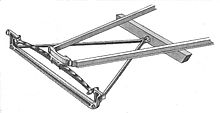Central joint axis

behind the rigid axle ("fist axle") a sliding V-shaped drawbar with a central ball joint at the tip

The central joint axis or drawbar axis is a rigid axis used on motor vehicles , which is connected centrally ( centrally ) to the car body via a drawbar and a ball joint . In the case of driven rear axles , the drawbar is usually a tube that is rigidly attached in the center of the axle and encloses the cardan shaft leading to the differential gear . The longitudinal forces are supported solely via the hinge on the drawbar; leaf springs , a Panhard rod or a Watt linkage are also used for lateral guidance along (picture below) or across (picture above) .
Central articulated axles were widely used until World War II ( Ford T and A front and rear, Austin 7 front). After that they were used less often: in passenger cars from Peugeot ( Peugeot 203 ff. To Peugeot 504 L at the back) and by Ford in the "humpback taunus" at the front; in the Unimog truck and in MAN buses .
There are also central joint axles, the axle beam of which is curved past the central joint, and which therefore do not have a drawbar. Panhard built it from 1945 with a V-shaped axle tube and Saab from 1955 with a U-shaped, both together with longitudinally installed handlebars. On the non-driven rear axle ( omega axle ) used by Fiat from 1986 onwards, the axle tube was cranked forward to the central bearing. The handlebars were tilted slightly. In the De-Dion axle of the Smart, which is driven via the rear wheels, the U-shaped axle tube encloses the drive unit consisting of the motor, manual and differential gear. The lateral forces are supported by the central joint in front of and above the engine and two wishbones, which means that the axis guidance is kinematically overdetermined. Soft rubber bearings and the elastic deformation of the axle tube compensate for the changing distance between the suspension points.
Central articulated axle at Opel
In the version called Opel central joint axis, the central joint can be moved in the direction of travel, whereby the function of longitudinal guidance was initially taken over by longitudinal leaf springs (Opel Kadett until 1967) and later by trailing arms. Instead of the leaf springs, coil springs were installed.
The design was used in many rear-wheel drive Opel models until 1988 - first in the Kadett A in 1962 . The Opel Kadett C ("T-Car") was produced by General Motors with this axle on all continents except Africa. The last Opel model with this central articulated axle variant in Germany was the Opel Manta B , which was built until 1988 .
This design (with Watt linkage instead of Panhard rod) can also be found in the Rover SD1 . The joint is offset slightly downwards and to the side.
Individual evidence
- ↑ Wolfgang Matschinsky: Wheel guides of road vehicles: kinematics, elasto-kinematics and construction . 2nd Edition. Springer, 1998, ISBN 978-3-662-09653-6 , pp. 182.183 . : ( limited preview in Google Book search)
- ↑ a b Jörnsen Reimpell: Fahrwerktechnik 1 Würzburg 1978, ISBN 3802305051 , p. 320 ff.
- ↑ Jörnsen Reimpell, Jürgen Betzler: Fahrwerktechnik. Basics. Würzburg 2005, ISBN 3834330310 , p. 72.